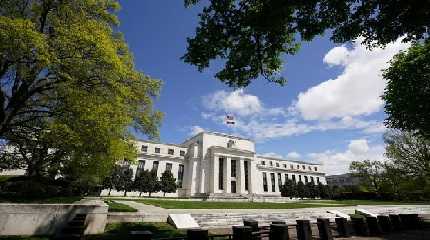
NEW YORK, March 26 (Xinhua) -- U.S. Federal Reserve officials' hint of a more aggressive hike of the benchmark interest rate in recent days pushed up key Treasury yields and concerns over a possible economic recession in 2023 or later.
John C. Williams, president of Federal Reserve Bank of New York, on Friday joined a chorus of a number of other central bankers saying he is open to raising interest rates by 50 basis points (bps) at some point.
Speaking at a virtual panel, Williams stressed the need to stay nimble along the way of "steadily" lifting interest rates going forward.
The Fed will, if needed, move "more aggressively" to raise the federal funds rate by more than 25 bps at its policy meetings to curb inflation, said Jerome Powell, chairman of both the U.S. Federal Reserve and the Federal Open Market Committee (FOMC) on Monday.
Loretta Mester, president of the Federal Reserve Bank of Cleveland, said Wednesday there was a need for some half percentage-point hikes while Charles Evans, president of the Federal Reserve Bank of Chicago, said Thursday he was open to such a big move despite his call to be careful in the process.
The Fed kicked off a new tightening cycle by raising the benchmark interest rate by 25 bps to a range of 0.25 percent to 0.5 percent on March 16.
A number of research institutions forecast more than one 50-bps rate hikes by the Fed this year in their latest reports.
The Fed would stage 50-bps hikes of interest rates at the monetary meetings in May, June, July and September, respectively, said economists with Citibank on Friday.
"We have changed our Fed call reflecting the Fed's acceptance that they are behind the curve," with expectation of faster rate hikes and a higher terminal rate, said Ethan Harris, head of global economics at Bank of America Global Research on Friday.
Harris expected the Fed would do 50-bps rate hikes in June and July and 25-bps rate hikes at all other monetary meetings until the policy rate reaches 3-3.25 percent in May 2023.
With inflation and wage growth surprising to the upside, the Fed seems to have run out of patience and is currently in inflation-fighting mode, said analysts with UBS Financial Services Inc. on Friday.
The yield of the 2-year Treasury note, which is sensitive to the federal funds rates, once reached 2.335 percent and closed at 2.28 percent on Friday, 14.6 bps higher from the previous session.
Meanwhile, the yield of 10-year Treasury bonds topped 2.5 percent, reaching the highest levels since late April 2019.
The recent flattening of the 2-year and 10-year Treasury yield curves brought by the faster rise of the 2-year Treasury yield led to concerns about risks of stagflation or recession in the U.S. economy.
The recent yield curves dynamics reflect recession risks and the "market seems to be challenging the soft-landing view for the U.S. economy that the Fed argued at the March FOMC meeting," said a recent research note by Bruno Braizinha, director of U.S. rates strategy at Bank of America.
The recession risks with the U.S. economy are low for now but could rise in the second half of 2023, said Aditya Bhave, economist with Bank of America Global Research on Friday.
The risk of a recession at some point in the next year or two has increased, said Goldman Sachs Chief Economist Jan Hatzius, who earlier put the chance of a recession of the U.S. economy over the next year at 35 percent.
UBS said the flattening of yield curves is not a sign that markets expect an imminent recession soon, and it predicted that the U.S. economy would continue to have an above-trend growth of 3.6 percent in 2022 in its central forecast case.




